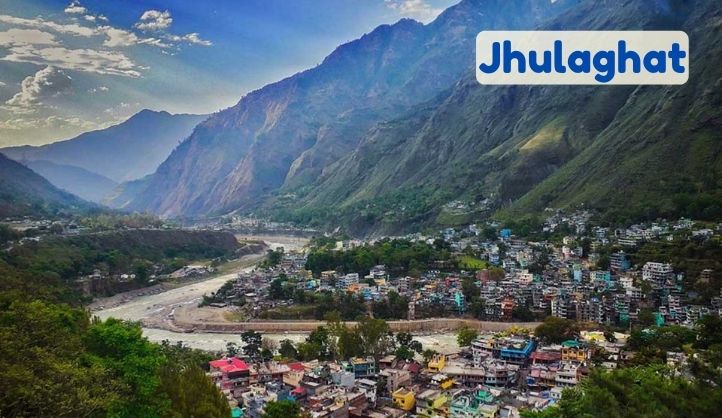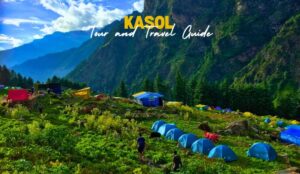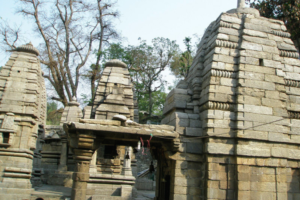Nestled in the picturesque district of Pithoragarh in the Indian state of Uttarakhand, Jhulaghat is a quaint town that offers a mesmerizing blend of natural beauty, cultural richness, and historical significance. Perched on the banks of the mighty Kali River, which forms the international border between India and Nepal, Jhulaghat serves as a vital link between the two countries. This idyllic town is not just a geographical marvel but also a gateway to exploring the hidden gems of the Kumaon region. In this comprehensive blog article, we will take you on a journey through the captivating landscape, cultural heritage, and unique experiences that Jhulaghat, Pithoragarh has to offer.
The Scenic Landscape
The Kali River: Lifeline of Jhulaghat
The Kali River, also known as the Sharda River in India, is the lifeline of Jhulaghat. Originating from the Greater Himalayas, this river meanders through the rugged terrain, offering breathtaking views and serving as a natural border between India and Nepal. The river is not only a vital source of water for the local communities but also a hub for various recreational activities. Tourists and locals alike enjoy river rafting, fishing, and boating on the Kali River, making it a focal point of adventure and relaxation.
Majestic Mountains and Verdant Valleys
Surrounded by the majestic Himalayas, Jhulaghat is a paradise for nature lovers. The town is enveloped by lush green forests, terraced fields, and verdant valleys that offer a tranquil environment. The panoramic views of the snow-capped peaks and the undulating landscape are a treat for the eyes and provide ample opportunities for trekking, hiking, and nature walks. The nearby hills and trails are ideal for both novice and experienced trekkers, offering an immersive experience in the lap of nature.
Flora and Fauna
Jhulaghat and its surrounding areas are rich in biodiversity, with a wide variety of flora and fauna. The dense forests are home to numerous species of trees, plants, and herbs, some of which have significant medicinal value. Wildlife enthusiasts can spot animals such as leopards, deer, Himalayan black bears, and a variety of birds. The region is also a haven for bird watchers, with many migratory and resident birds frequenting the area, including the colorful Himalayan monal, the state bird of Uttarakhand.
How to reach Jhulghat in Pithoragarh
By Air
The nearest airport to Jhulaghat is Pantnagar Airport, located approximately 230 kilometers away.
By Rail
The nearest railway station to Jhulaghat is Tanakpur Railway Station, located about 150 kilometers away.
By Road
Jhulaghat is well-connected by road to major cities and towns in Uttarakhand and neighboring states. Driving from Delhi to Jhulaghat takes around 12-14 hours. The route typically followed is Delhi → Haldwani → Almora → Pithoragarh → Jhulaghat. You can take an overnight bus from Delhi to Pithoragarh. From Pithoragarh, buses and shared taxis are available to Jhulaghat.
Cultural and Historical Significance
A Melting Pot of Cultures
Jhulaghat are a unique cultural crossroads where Indian and Nepali cultures blend seamlessly. The town is inhabited by a mix of ethnic groups, including the Kumaoni people, who are the predominant community in Pithoragarh, and various Nepali communities. This cultural diversity is reflected in the local traditions, festivals, cuisine, and daily life. Festivals like Holi, Diwali, and Dashain are celebrated with equal enthusiasm, showcasing the harmonious coexistence of different cultures.
Historical Monuments and Temples
The historical significance of Jhulaghat is evident from the numerous ancient temples and monuments scattered across the region. One of the prominent temples is the Sri Jhulaghat Kali Mandir, dedicated to the goddess Kali. This temple, situated on the banks of the Kali River, attracts devotees from both India and Nepal. The architecture and intricate carvings of the temple are a testament to the rich cultural heritage of the region.
Another noteworthy site is the Pithoragarh Fort, located a short distance from Jhulaghat. This ancient fort, believed to have been built by the Chand dynasty rulers, offers a glimpse into the historical and architectural prowess of the era. The fort provides panoramic views of the surrounding landscape, making it a popular tourist attraction.
Adventure and Recreation
Trekking and Hiking
For adventure enthusiasts, Jhulaghat offers an array of trekking and hiking trails that cater to all levels of experience. The nearby Askot Wildlife Sanctuary, located about 50 kilometers from Jhulaghat, is a popular destination for trekkers. The sanctuary is home to the endangered musk deer and offers stunning views of the Himalayas, making it an ideal spot for trekking and wildlife photography.
The Pithoragarh to Jhulaghat trek is another popular route, taking trekkers through picturesque villages, terraced fields, and dense forests. This trek provides a unique opportunity to experience the natural beauty and cultural richness of the region.
River Rafting and Fishing
The Kali River, with its turbulent waters and scenic surroundings, is a hotspot for river rafting. Adventure seekers can enjoy the thrill of navigating the rapids while soaking in the breathtaking views of the Himalayas. Fishing is another popular activity on the Kali River, with the river teeming with various species of fish, including trout and mahseer.
Camping and Nature Walks
Camping along the banks of the Kali River or in the verdant valleys surrounding Jhulaghat is an experience like no other. The tranquil environment, coupled with the sounds of nature, provides a perfect setting for a relaxing getaway. Nature walks in the nearby forests offer a chance to explore the rich biodiversity and enjoy the fresh mountain air.
Local Cuisine and Handicrafts
Culinary Delights
The cuisine of Jhulaghat is a delightful blend of Kumaoni and Nepali flavors. Local dishes are prepared using fresh, locally sourced ingredients and traditional cooking methods. Some of the must-try dishes include:
- Aloo Ke Gutke – Aloo Ke Gutke popular Kumaoni dish made with boiled potatoes, seasoned with local spices, and garnished with fresh coriander.
- Bhatt Ki Churkani – A Bhatt Ki Churkani is a nutritious curry made with black soybeans, commonly known as bhatt, cooked with spices and served with rice or roti.
- Dal Bhat – A staple Nepali dish consisting of lentil soup (dal) served with steamed rice (Bhat) and accompanied by various side dishes like vegetables, pickles, and curd.
- Sidu – A Sidu traditional Kumaoni bread made with wheat flour and stuffed with a mixture of roasted black sesame seeds and jaggery.
Handicrafts and Souvenirs
Jhulaghat is also known for its vibrant handicrafts, which reflect the rich cultural heritage of the region. Local artisans create beautiful handmade products such as woolen shawls, carpets, and wooden carvings. These handicrafts make for perfect souvenirs and offer a glimpse into the traditional craftsmanship of the region.
Best Time to Visit
The best time to visit Jhulaghat is spring and autumn, from March to June and September to November. During these periods, the weather is pleasant, and the natural beauty of the region is at its peak. The monsoon season, from July to August, brings heavy rainfall, which can cause roadblocks and landslides, making travel challenging. Winter months, from December to February, can be quite cold, with temperatures dropping significantly, but they offer a unique experience with snow-covered landscapes.
Nearby places to explore
Pithoragarh
Pithoragarh is the district headquarters and a bustling town offering a blend of historical, cultural, and natural attractions.
Pithoragarh Fort – An ancient fort providing panoramic views of the surrounding landscape.
Kapileshwar Mahadev Temple –: A revered Shiva temple situated in a cave, offering spiritual solace and scenic views.
Askot Wildlife Sanctuary – Askot Wildlife Sanctuary is known for its rich biodiversity, including the endangered musk deer.
Dharchula
Dharchula is a picturesque town located on the banks of the Kali River, near the India-Nepal border.
Kali River – Enjoy the serene beauty and engage in activities like river rafting and fishing.
Narayan Ashram – A spiritual retreat offering tranquility and beautiful surroundings.
Om Parvat – A sacred mountain that attracts pilgrims and trekkers for its spiritual significance and natural beauty.
Munsiyari
Munsiyari is a charming hill station known for its breathtaking views of the Panchachuli peaks and trekking routes.
Panchachuli Peaks – Panchachuli Peaks has Stunning views of the five snow-capped peaks.
Birthi Falls – A Birthi Falls majestic waterfall surrounded by lush greenery.
Khalia Top – A popular trekking destination offering panoramic views of the Himalayan ranges.
Chaukori
Chaukori is a serene hill station renowned for its tea gardens and panoramic views of the Himalayan ranges.
Tea Gardens – Lush tea estates offering a tranquil environment and picturesque views.
Nagmandir Temple – A temple dedicated to the serpent deity with Sunrise and Sunset Views – Famous for its breathtaking sunrise and sunset views over the Himalayas.
Lohaghat
Lohaghat is a historic town with lush greenery and significant religious sites.
Abbott Mount – A Abbott Mount quaint hill station offering beautiful colonial architecture and panoramic views.
Mayawati Ashram – A Mayawati Ashram spiritual retreat and headquarters of the Advaita Ashrama.
Vanasur Ka Kila – An ancient fort with mythological significance.
Gangolihat
Gangolihat is known for its ancient temples and caves, offering a blend of spirituality and natural beauty.
Haat Kalika Temple – A Haat Kalika Temple revered temple dedicated to the goddess Kali.
Patal Bhuvaneshwar – A Patal Bhuvaneshwar mystical cave temple with intricate rock formations and mythological significance.
Conclusion
Jhulaghat, Pithoragarh, is a hidden gem that perfectly blends natural beauty, cultural richness, and adventure. Whether you are a nature enthusiast, a history buff, an adventure seeker, or a cultural explorer, Jhulaghat has something to offer for everyone. The serene environment, coupled with the warm hospitality of the locals, makes it an ideal destination for a memorable getaway. As you explore the enchanting landscapes, immerse yourself in the local culture, and indulge in unique experiences, you will undoubtedly fall in love with the charm and beauty of Jhulaghat. So pack your bags and embark on an unforgettable journey to discover the magic of Jhulaghat, Pithoragarh.
FAQs about Jhulaghat, Pithoragarh
1. Where is Jhulaghat located?
Jhulaghat is located in the Pithoragarh district of Uttarakhand, India, on the banks of the Kali River, which forms the border between India and Nepal.
2. How do I reach Jhulaghat?
- By Air: The nearest airport is Pantnagar Airport, about 230 kilometers away. From there, you can hire a taxi or take a bus to Jhulaghat.
- By Rail: The nearest railway station is Tanakpur Railway Station, approximately 150 kilometers away. From there, you can take a bus or taxi to Jhulaghat.
- By Road: Jhulaghat is well-connected by road to major cities in Uttarakhand. You can drive or take a bus from cities like Delhi, Dehradun, and Haldwani to reach Jhulaghat.
3. What is the best time to visit Jhulaghat?
The best time to visit Jhulaghat is during the spring (March to June) and autumn (September to November) months when the weather is pleasant and the natural beauty is at its peak. Avoid the monsoon season (July to August) due to heavy rainfall and possible landslides.
4. What are the major attractions in Jhulaghat?
- Kali River: Ideal for river rafting, fishing, and boating.
- Sri Jhulaghat Kali Mandir: A prominent temple dedicated to the goddess Kali.
- Pithoragarh Fort: An ancient fort offering panoramic views of the region.
- Askot Wildlife Sanctuary: A popular destination for trekking and wildlife photography.
5. What activities can I do in Jhulaghat?
- Trekking and Hiking: Explore various trails in the surrounding hills and forests.
- River Rafting and Fishing: Enjoy adventure activities on the Kali River.
- Camping: Camp along the riverbanks or in the valleys.
- Nature Walks: Discover the rich biodiversity of the area through guided nature walks.





